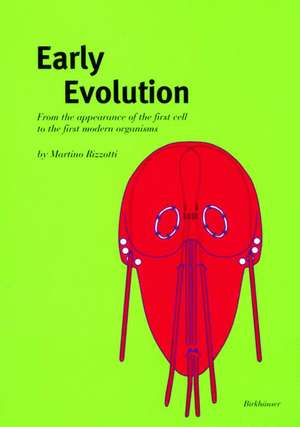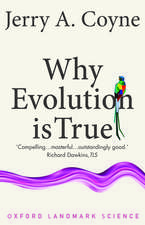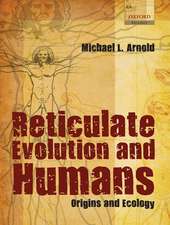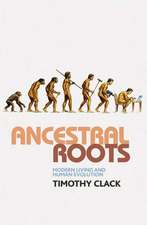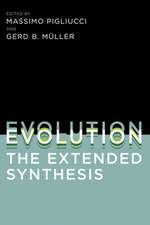Early Evolution: From the appearance of the first cell to the first modern organisms
Autor Martino Rizzottien Limba Engleză Paperback – 14 feb 2000
Preț: 388.90 lei
Nou
Puncte Express: 583
Preț estimativ în valută:
74.42€ • 80.81$ • 62.52£
74.42€ • 80.81$ • 62.52£
Carte tipărită la comandă
Livrare economică 22 aprilie-06 mai
Preluare comenzi: 021 569.72.76
Specificații
ISBN-13: 9783764361914
ISBN-10: 3764361913
Pagini: 184
Ilustrații: VI, 176 p. 33 illus.
Dimensiuni: 170 x 240 x 10 mm
Greutate: 0.44 kg
Ediția:2000
Editura: Birkhäuser Basel
Colecția Birkhäuser
Locul publicării:Basel, Switzerland
ISBN-10: 3764361913
Pagini: 184
Ilustrații: VI, 176 p. 33 illus.
Dimensiuni: 170 x 240 x 10 mm
Greutate: 0.44 kg
Ediția:2000
Editura: Birkhäuser Basel
Colecția Birkhäuser
Locul publicării:Basel, Switzerland
Public țintă
ResearchCuprins
1 Introduction.- 2 The First Cell.- 2.1 Properties attributed to the first cell: reproduction.- 2.2 Properties other than reproduction.- 2.3 Derivation of the first cell from a precellular aggregate.- 2.4 There are many kinds of putative aggregates.- 2.5 A detailed hypothesis on the formation of the first cell.- 2.6 Properties attributed to modern cells.- 2.7 Temporal frame.- 3 Modern Cells: Prokaryotic and Eukaryotic Descents.- 3.1 The general pattern of descent lineages remains controversial.- 3.2 Descent is traditionally inferred from morphological comparison.- 3.3 Descent inferred from gene sequences is not truly universal.- 3.4 The possible origin of a protein complex.- 3.5 What was the cellular organization of the common ancestor?.- 3.6 Major evolutionary transitions.- 4 Prokaryotes: The Flagellum.- 4.1 The bacterial flagellum is a complex structure.- 4.2 Complex structures appear only once.- 4.3 From what did the flagellum derive?.- 4.4 Possible derivation series.- 5 Prokaryotes: The Outer Membrane.- 5.1 The outer membrane is also a complex structure.- 5.2 Was the outer membrane an alimentary adaptation?.- 5.3 Did the outer membrane appear in a flagellated bacterium?.- 5.4 The role of interspecific gene transfers.- 6 Prokaryotes: Trends towards Complexity.- 6.1 Cell differentiation.- 6.2 Multicellularity.- 6.3 Particles which escaped from cells.- 7 The Appearance of the Nucleus.- 7.1 Eukaryotes are defined by the nucleus.- 7.2 The nucleus requires an intracellular skeleton.- 7.3 Did the nucleus appear inside an indeterminate cell?.- 7.4 Did the nucleus appear inside a bacterium?.- 7.5 Did the nucleus derive from an intracellular bacterium?.- 7.6 The origin of nuclear linear chromosomes.- 8 Eukaryotes: Dictyosomes.- 8.1 From what did dictyosomes derive?.- 8.2 Progress in membrane traffic.- 8.3 Did some vesicles derive from intracellular symbiosis?.- 9 Eukaryotes: The Mitochondrial Symbiosis.- 9.1 Mitochondria are bacteria adapted to intracellular life.- 9.2 Primitive engulfment and origin of mitochondria.- 9.3 Alternative hypotheses on the origin of mitochondria.- 9.4 Have Eukaryotes without mitochondria always been so?.- 10 Eukaryotes: Plastidial Symbioses.- 10.1 Plastids are also bacteria adapted to intracellular life.- 10.2 Intermediate adaptations on the way to plastidial symbioses.- 10.3 Parallel symbioses.- 10.4 Serial symbioses.- 10.5 Plastidial regressions.- 11 Eukaryotes: The Cilium.- 11.1 A surprising and complicated geometry.- 11.2 Ideas to explain the geometry of the cilium.- 11.3 Did the cilium derive from a specialization of the intracellular skeleton?.- 11.4 Did the cilium derive from extracellular symbiosis with a Spirochete?.- 11.5 Before and after the appearance of the cilium.- 12 Eukaryotes: Complexity and Gigantism.- 12.1 The fixation of sex.- 12.2 Cell differentiations.- 12.3 Multicellularity.- 13 Conclusions.- Acknowledgements.- References.
Caracteristici
DEALS WITH THE NEGLECTED PART OF BIOLOGICAL EVOLUTION WHICH RANGES FROM THE ORIGIN OF THE FIRST CELL TO THE FIRST MODERN CELLS AND ORGANISMS GIVES A CLEAR IDEA ON THE WHOLE COURSE OF BIOLOGICAL EVOLUTION AND A COMPASS TO ORIENT IN THE CONFUSED DEBATE ON THE MOST NEGLECTED BUT CRUCIAL STAGE OF BIOLOGICAL EVOLUTION ITSELF NEW HYPOTHESES ARE PRESENTED ON THE ORIGIN OF SOME OF THE DISCUSSED CELLULAR STRUCTURES
